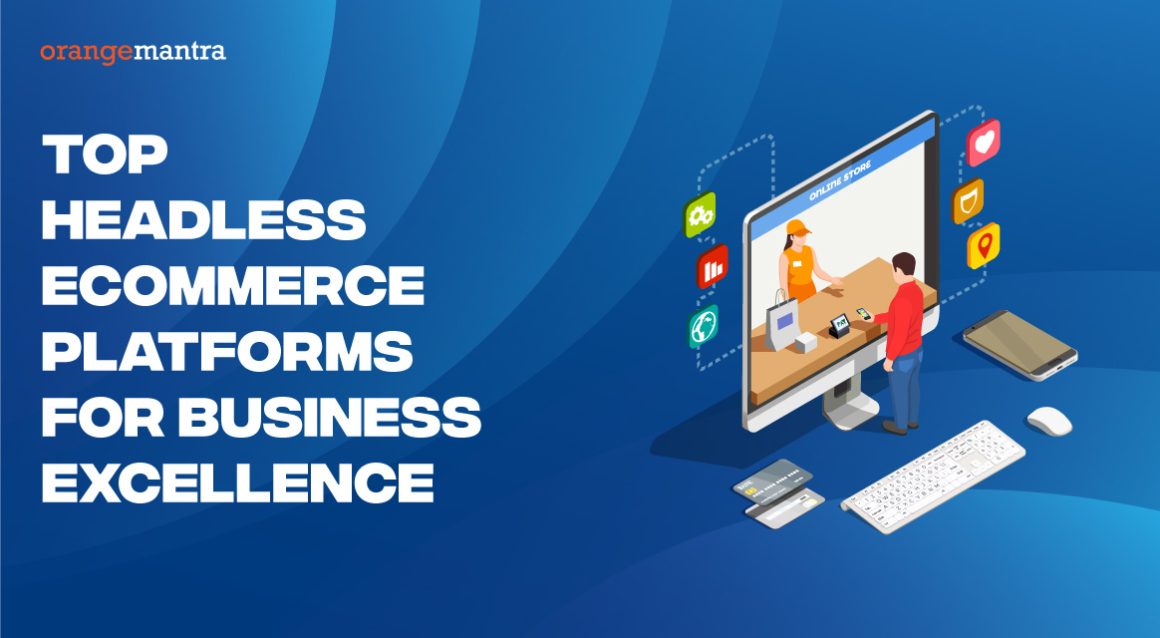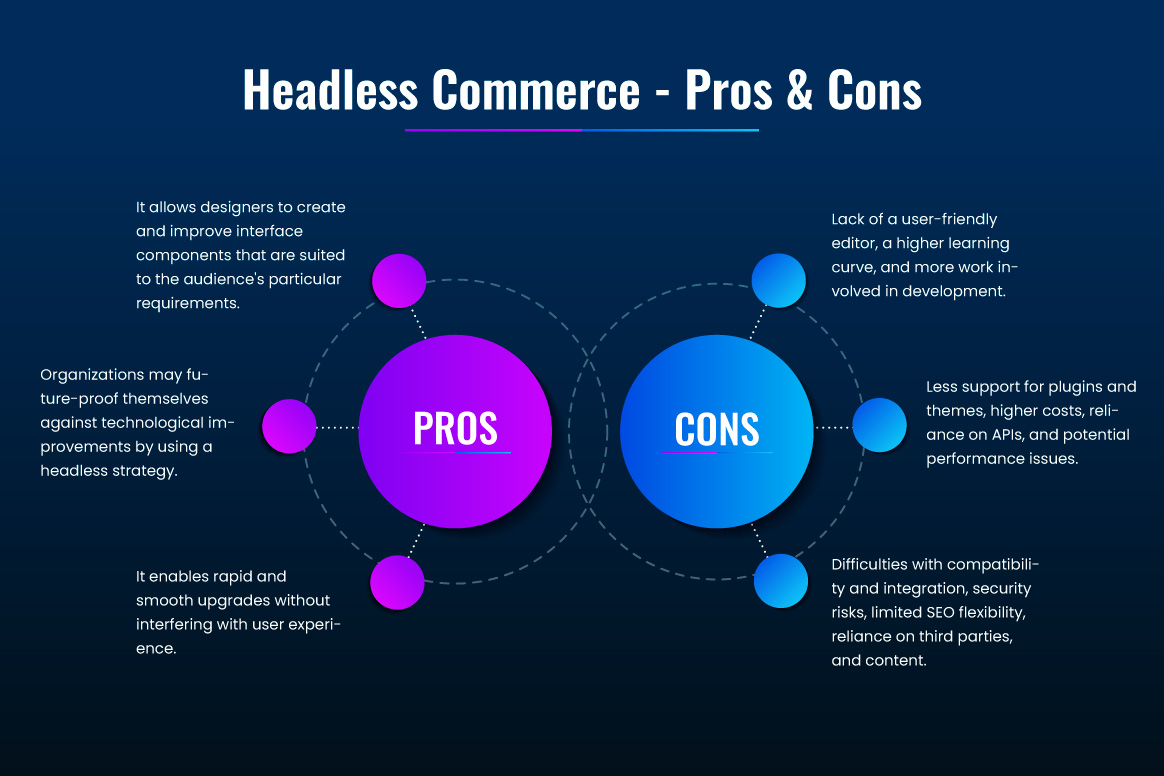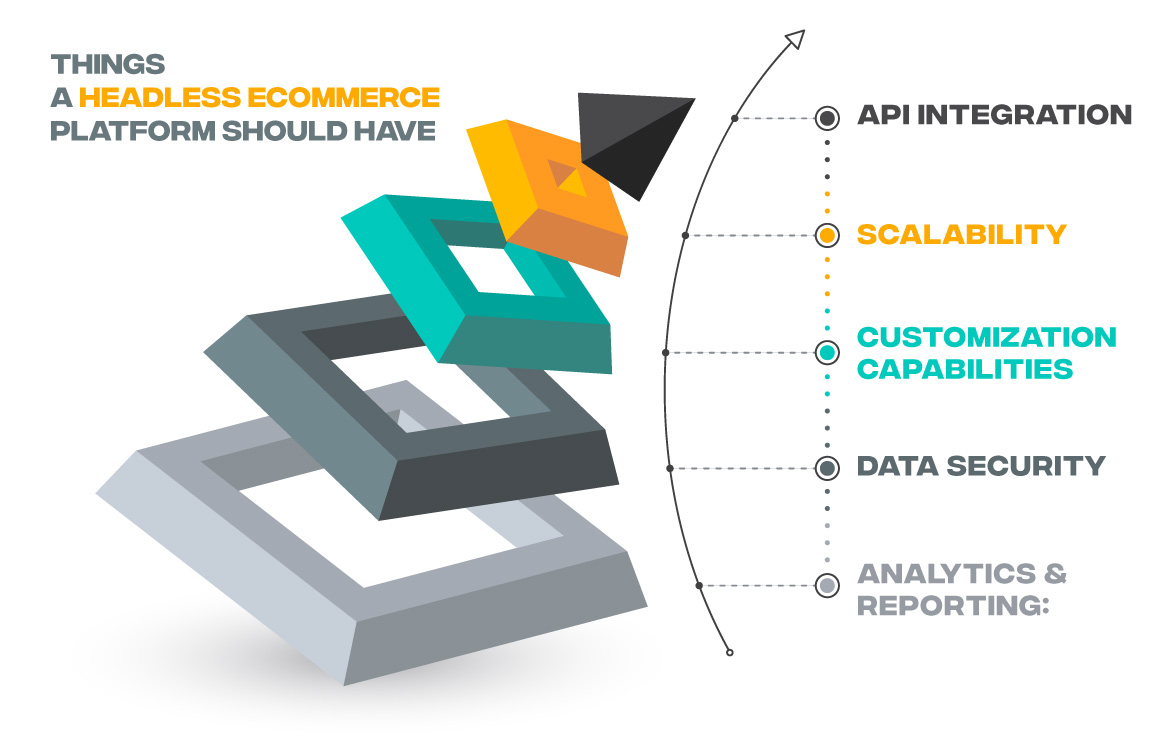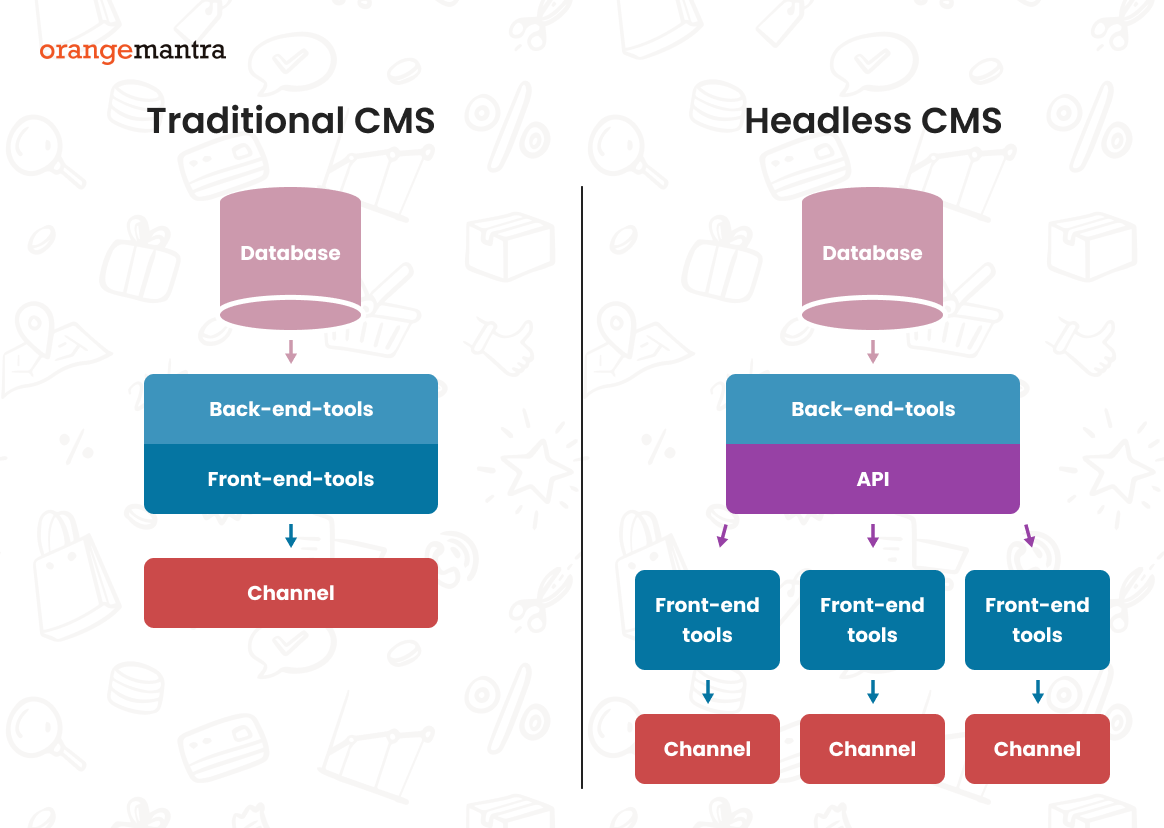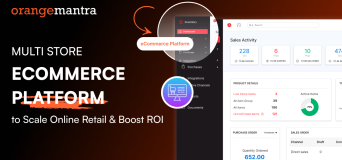Businesses are continuously looking for novel ideas to keep ahead of the competition in today’s dynamic digital market. Headless eCommerce is one such option that has become quite popular recently. With this cutting-edge method of online commerce, you can expect unsurpassed flexibility, scalability, and easy CMS integration. We will investigate the benefits of headless Commerce in this blog and provide a detailed analysis of the top headless eCommerce platforms and CMS solutions to consider in 2025.
Table of Contents
How Headless eCommerce is Changing the Retail Business?
The term “headless eCommerce” describes a decoupled architecture in which the front-end display layer (the “head”) is isolated from the back-end commerce operations, including product catalogs, inventory control, and transaction processing. With headless eCommerce, companies can completely manage the consumer experience independent of the device or channel, in contrast to conventional eCommerce systems.
This strategy equips businesses to provide consistent, personalized user experiences that guarantee easy navigation and engagement. Omnichannel commerce solutions development company provides effective solutions for the SME’s and helps them to grow in a rapid way.
Top Benefits of Headless eCommerce in 2025
It allows designers to create and improve interface components that are suited to the audience’s particular requirements.
- A distinctive, aesthetically appealing, and engaging UI that strengthens brand identification is guaranteed by this independence.
- Headless commerce makes use of APIs, it makes it simple to integrate with other services, easing operations and improving overall functionality.
- Organizations may future-proof themselves against technological improvements by using a headless strategy.
- Headless eCommerce solutions enable rapid and smooth upgrades without interfering with user experience.
Cons of Headless eCommerce
- Lack of a user-friendly editor, a higher learning curve, and more work involved in development.
- Less support for plugins and themes, higher costs, reliance on APIs, and potential performance issues.
- Difficulties with compatibility and integration, security risks, limited flexibility, reliance on third parties, and content.
Information on the Development of Headless Commerce
Headless Commerce has advanced in a way that is quite astounding. Recent research indicates:
- By 2027, the headless eCommerce industry is projected to have grown rapidly and be widely used, with a startling value of $5.8 billion.
- Headless commerce has already been adopted by around 35% of internet enterprises, and this percentage is rapidly rising year after year.
After converting to a headless strategy, businesses across a variety of sectors, including fashion and beauty, electronics, and B2B services, saw measurable gains in conversion rates, bounce rates, and customer satisfaction. There are effective solutions for eCommerce and Retail Industry. The usefulness and promise of headless eCommerce in revolutionizing the digital world are clearly shown by these numbers.
Things a Headless eCommerce Platform Should Have
Several important criteria need to be considered when choosing a headless eCommerce platform for your company:
1- API Integration:
To guarantee smooth connectivity with diverse front-end systems and third-party apps, a strong and adaptable API architecture is essential. Look for systems that provide thorough API support and documentation.
2- Scalability:
Having a platform that can handle growing client needs is crucial as your organization grows. Make sure the platform you choose has strong scaling capabilities and can manage heavy traffic loads without sacrificing speed.
3- Customization Capabilities:
A key benefit of headless eCommerce is the capacity to customize the consumer experience. Look for systems that provide extensive customization possibilities so you may design beautiful and distinctive user interfaces.
4- Data Security
Data security should be a primary focus in the age of growing cyber threats. Pick a platform that provides cutting-edge security safeguards like encryption, firewalls, and frequent security upgrades.
5- Analytics and Reporting
Useful information about consumer behavior and purchase trends is essential for company growth. To monitor and analyze important indicators, use a platform that offers complete analytics and reporting features. The portfolio of eCommerce Website Design and development depends highly on the development phase and also on the Analytics and Reporting.
Choose a platform with strong Omnichannel support and integrations to guarantee a smooth user experience across numerous channels, such as online, mobile, and social media.
Traditional vs. Headless eCommerce: What’s the Difference?
There are two methods for creating online stores: headless eCommerce and Traditional eCommerce. Traditional eCommerce systems often provide an all-in-one solution with closely integrated front- and back-ends. Headless eCommerce, on the other hand, enables a decoupled architecture by isolating the frontend display layer from the backend functionality. The B2B eCommerce platform development strategy offers adaptability, scalability, and the possibility to employ different front-end frameworks.
Comparison of The Benefits and Features of Traditional and Headless eCommerce
It’s crucial to contrast headless eCommerce with conventional eCommerce to properly comprehend its advantages:
Headless eCommerce
- Offers unrivaled customization and flexibility choices.
- Enables easy integration with different CMS systems.
- Enables companies to provide individualized and consistent user experiences across channels and devices.
- Protects businesses from technological developments.
- Provides improved performance and scalability.
Traditional eCommerce
- Usually integrates back-end and front-end features into a single platform.
- Fewer customization and flexibility choices.
- The ability to integrate with different CMS systems may be restricted.
- Gives users a more uniform experience.
- To adapt to changing technology, more considerable development effort can be needed.
Platforms for eCommerce that Support a Headless Approach
Let’s look at some of the top eCommerce systems that support this strategy now that we know the benefits of headless eCommerce and what to look for in a platform:
- Shopify Plus, which is well known for its seamless integration abilities, enables companies to combine the strength of headless commerce with its powerful CMS features.
- Through its wide APIs, Magento Commerce, which is renowned for its scalability and vast customization possibilities, provides a fantastic headless eCommerce solution.
- BigCommerce helps companies provide excellent user experiences across a variety of channels thanks to its flexible API architecture and specialized headless commerce alternatives.
- Originally a CMS-first platform, Contentful is now a viable candidate for companies looking for a scalable and adaptable headless eCommerce solution thanks to its headless approach and comprehensive APIs.
- Storyblok provides a distinctive and user-friendly content management system that uniquely interfaces with eCommerce systems, enabling a quick and effective workflow.
- Storyblok was created exclusively for headless commerce.
CMSs That Support Headless Integrations with eCommerce
Several platforms stand out when it comes to selecting the best CMS for headless eCommerce integrations because of their cutting-edge capabilities and benefits in retail commerce:
1- Shopify Plus
Shopify Plus is one of the top headless eCommerce platforms that provides strong headless Shopify eCommerce solutions and headless commerce tools that enable merchants to design individualized customer journeys.
- Shopify Plus provides a simple connection with any front-end technology thanks to its API-first approach.
- Retailers can use headless commerce to personalize their storefront, increase user experience, and optimize performance.
2- BigCommerce
Another potent headless commerce platform that meets the unique demands of shops is BigCommerce.
- BigCommerce offers flexibility in terms of front-end development because of its scalable design.
- Retailers can apply distinctive design features and provide a customized buying experience by using headless commerce.
3- Magento (Adobe Commerce)
The headless commerce solution provided by Magento, which is recognized for its versatility, satisfies the needs of retail commerce. Magento development services play an effective role in the development and the retail sector too.
- A seamless interface with front-end technology is made possible by Magento’s robust collection of APIs, delivering a positive shopping experience.
- Retailers can use the headless method to design unique storefronts, add distinctive features, and enhance performance.
- Magento Commerce Cloud plays an important role in the development phase for the SMEs.
4- Commerce Tools
With its API-driven methodology, Commerce Tools distinguishes itself as a headless commerce platform that gives merchants more control.
- Retailers can create customized shopping experiences using Commerce Tools, which allows for smooth integration with a variety of front-end frameworks.
- Retailers can grow their online storefronts based on their own company demands thanks to this flexibility.
5- Snipcart
Snipcart is one of the top headless eCommerce platforms retailers can adopt Snipcart’s user- and developer-friendly headless commerce solution.
- Retailers can take a headless strategy and develop distinctive shopping experiences rapidly thanks to its simple integration and customization possibilities.
- By integrating headless commerce capabilities, Snipcart gives retailers the chance to improve their online storefronts.
6- Zesty
With its flexible front-end features, Zesty is a headless Commerce platform that emphasizes enabling businesses. Top headless eCommerce platforms Zesty is an effective CMS system.
- Retailers can customize their storefronts and provide enjoyable shopping experiences using Zesty’s headless commerce strategy.
- Retailers can optimize efficiency and provide a remarkable consumer experience thanks to the choices for a seamless connection.
7- Graph CMS
Retailers can simply interface with headless eCommerce systems thanks to Graph CMS, a headless CMS solution.
- The total customer experience can be improved by retailers by using Graph CMS to organize and distribute information across a variety of channels effectively.
- Graph CMS is a good option for merchants searching for a headless eCommerce connection solution due to its simplicity of use and versatility.
Final Thoughts
Adopting headless eCommerce is becoming more and more important as online companies develop and work to provide top-notch user experiences. Businesses may access incredible customization choices, seamless connections, and future-proof their digital presence by adopting a headless strategy and choosing the appropriate platform. Planning for success in 2025 and beyond requires considering the benefits and possibilities of headless eCommerce platforms given the rapidly changing digital world.
FAQ
Q1. Do conventional and headless eCommerce systems vary from one another?
Yes, the primary distinction between headless platforms and conventional platforms is the separation of the front end and back end. The front end may now be more flexible and customized thanks to this division.
Q2. Which headless eCommerce system is ideal for small businesses?
Small companies often choose Shopify Plus and BigCommerce because of their scalability and user-friendly interfaces. eCommerce web development company in Gurgaon can provide effective services for all SME’s.
Q3. Which headless eCommerce platform is ideal for big businesses?
Due to its numerous customization choices and powerful backend capabilities, large businesses often choose Magento Commerce (Adobe Commerce).
Q4. How do I choose the best headless eCommerce system for my company?
When selecting a platform, keep things like your company’s size, scalability requirements, budget, desired features, and development resources in mind. eCommerce consulting service gives proper information regarding the task and the development phase.
Q5. Is the cost of headless eCommerce systems higher than that of regular ones?
Due to development expenses, headless eCommerce systems might be costlier to set up initially, but they enable scalability and customization that can result in cost savings over time.
